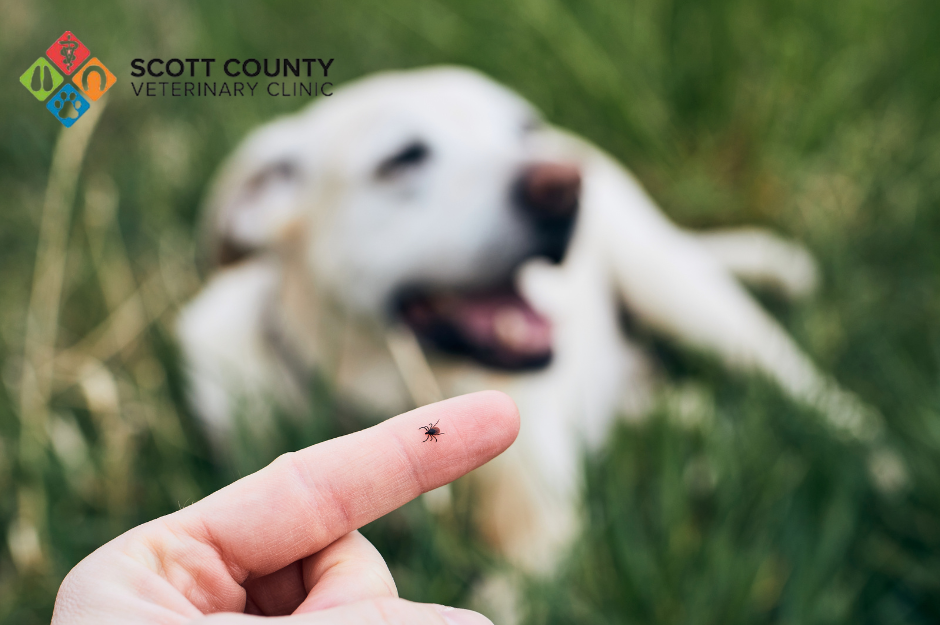You’re probably aware that preventing ticks is an important part of caring for your pet. But what are exactly are these baleful bugs that binge on blood?
Ticks are parasitic arthropod species in the order Ixodidae. Ixos is a Latin word that means ‘sticky’. If you’ve ever tried to remove one of these obnoxious critters you’ll know that this is an accurate description for these pests. There are about 900 species of ticks broken down into two broad categories; “hard bodied” and “soft bodied” ticks. Both groups have four stages in their life cycle: egg, larva, nymph and adult. All ticks are external parasites that only eat blood. They are able to go without food for a long time, but require a meal of blood to move from one stage of life to the next.
Where and how the tick spends its time developing depends on the species, but there are 3 general methods they use. One-host ticks, as the name implies, spend all their time on one host. They hatch from their egg, latch on to a host, feed, grow, and mate all on the host. The females eventually leave to lay her eggs in the environment. Two-host ticks, you guessed it, spend time on two separate hosts. They usually leave the first host when they’re ready to molt into adult hood, which they generally do in the winter. They find a second host to attach themselves to and prepare for egg laying. The third strategy is, unsurprisingly, three-host ticks. The more host that a tick has had before your pet, the more likely they are to be carrying a disease that they could unintentionally spread.

What Can We Do
Controlling the outside environment can be helpful. To do so we have to think about what would make our yards a place that ticks would like to be. Removing leaf litter, tall grasses/brush, or any furniture/trash from yards and edges of property helps reduce the hiding spots that ticks take advantage of. Discouraging wildlife can help prevent multi-host ticks from laying eggs in our yards. Using fencing, removing debris/rot and keeping any wood piles in neat dry areas can cut down on deer, rodents or other wildlife from dropping ticks into our grass. A 3-foot wide barrier of wood chips or gravel placed between lawns and wooded areas also helps prevent ticks from migrating into yards.
The inside environment is already a place that ticks typically avoid, with one glaring exception, our pets! So the simplest method of making this inside environment hostile to the ticks is to keep our dogs and cats on flea and tick prevention. For most of the serious illnesses that ticks spread, the parasite must be attached for a period of time before the disease causing agent is spread to the host. Lyme disease, for instance, seems to take at least 48 hours. This means that if we can remove the tick before that time frame is done we can prevent the infection.

Tick Removal
Fine tipped tweezers can be used to remove an attached tick. We recommend grasping the tick as close to the surface of the skin as possible. Then, using steady, even pressure pull directly away from the skin. Twisting/jerking motions increase the risk of separating the mouth of the tick from its body. After removing the tick it is recommended to disinfect the area with an iodine scrub or even soap and water. Disposal of the tick can be performed by submerging it in alcohol, sealing it in an airtight bag or container, wrapping it in taper or flushing it down the toilet. It is never recommended to crush a tick in your fingers.
You should not attempt to remove ticks using hot matches, petroleum jelly, turpentine, nail polish or rubbing alcohol alone. All of these methods increase various risk factors to your pet and are not as effective as removal with tweezers. The risk of disease transmission to your or your family from a tick that you are removing/have removed is very low. With that said good hygiene is always wise, and humans are of course at risk from ticks attached to them.
Monitoring pets
Most veterinarians recommend constant year round tick prevention to keep the risk to your pets as low as possible. However, even with these measures we can never completely eliminate the risk. As such we like to make yearly screening part of the game plan for your hirsute homeboys. The most common diseases that are transmitted by ticks in our area include Anaplasmosis, Lyme disease, Ehrlichia, and, less commonly, Rocky Mountain Spotted Fever and Tick Paralysis. These diseases can present with a variety of signs and symptoms, but commonly we see fevers, lethargy, and joint pain.

Takeaways
Overall, ticks are certainly a nuisance and can cause your pet and your pocket book unnecessary pain. Simple maintenance flea/tick prevention is the most effective way to keep your house tick free. There are several other environmental factors that can be addressed but they are less effective than preventions. Prompt removal of any ticks that are seen are on your pet is also important but, again, preventions are preferred. So, when you hear your vet harping on flea and tick prevention, now you know why.
References
https://veterinarypartner.vin.com/default.aspx?pid=19239&id=4952474

